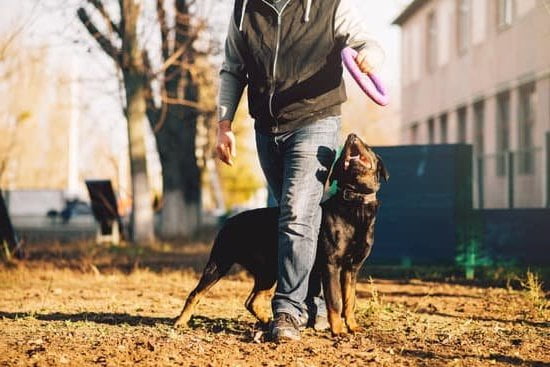Training a stubborn dog to walk on a leash can be a challenging task for many owners. Stubborn dogs often exhibit strong-willed behaviors that make them resistant to training and prone to pulling or lunging while on walks. In this article, we will explore effective strategies and techniques to help you train your stubborn dog to walk calmly on a leash.
Understanding the characteristics of stubborn dogs is crucial in developing an effective training plan. These dogs are typically independent, strong-minded, and determined, which can make them more resistant to following commands or guidelines. This makes leash training essential for not only their safety but also for the convenience of their owners.
Setting a strong foundation based on trust and respect is key in working with a stubborn dog. Building a positive relationship with your canine companion is paramount before starting leash training. Through bonding exercises and positive reinforcement techniques, you can establish trust and create an environment where your dog feels secure and receptive to instruction.
By selecting the right leash and collar, you can enhance both comfort and control during training sessions. Understanding the different types of leashes and collars available will help you choose the appropriate equipment based on your dog’s size, behavior, and specific needs.
In the following sections of this article, we will delve deeper into these topics as we guide you through the step-by-step process of training your stubborn dog to walk on a leash. We will address common challenges such as pulling, lunging, and distractions, providing practical techniques to overcome them. Additionally, we will highlight common mistakes to avoid during training and offer suggestions for reinforcing good behavior in order to maintain proper leash etiquette.
With dedication, consistency, patience, and positive reinforcement techniques outlined in this article, you can transform your stubborn dog into a well-behaved companion who thoroughly enjoys walking on a leash. Remember that every small victory along the way should be celebrated as progress towards achieving harmonious walks with your beloved pet.
Setting the Foundation
Establishing a positive and strong relationship with your stubborn dog is crucial before beginning leash training. Building trust and respect between you and your dog will create a solid foundation for successful training sessions. Taking the time to bond with your furry friend will help them feel secure, making the training process more effective.
One important aspect of building a positive relationship is spending quality time together. Engage in bonding exercises such as playing games, going on walks, or simply cuddling on the couch. These activities allow you to connect with your dog on an emotional level and build mutual trust.
Positive reinforcement is another key element in establishing a strong bond. Rewarding your dog for good behavior encourages them to repeat those behaviors in the future. Use treats, verbal praise, or petting as rewards when your dog exhibits desirable actions such as sitting calmly or walking beside you. By consistently rewarding positive behavior, you are teaching your dog that good things happen when they follow instructions.
In addition to bonding exercises and positive reinforcement techniques, it is important to set clear boundaries and establish yourself as the pack leader. Consistency in rules and commands will help your stubborn dog understand what is expected of them. Using simple cue words like “sit,” “stay,” or “heel” along with corresponding hand signals will also aid in clear communication between you and your pet.
| Key Tips for Establishing a Positive Relationship: |
|---|
| – Spend quality time bonding with your dog |
| – Engage in positive reinforcement techniques |
| – Set clear boundaries and establish yourself as the pack leader |
Selecting the Right Leash and Collar
The Importance of Choosing the Right Equipment
When it comes to leash training a stubborn dog, selecting the right leash and collar is crucial. The equipment you choose can have a significant impact on the success of your training sessions and your dog’s overall comfort. There are various types of leashes and collars available in the market, each with its own purpose and benefits.
Understanding Different Types of Leashes
One option to consider is a standard leash, which typically ranges from 4 to 6 feet long. These leashes are simple and versatile, allowing you to maintain control while giving your dog enough freedom to move comfortably during walks. Another popular option is a retractable leash, which can extend up to 25 feet or more. This type of leash provides more freedom for your dog but requires extra caution as it may lead to pulling or tangling.
For dogs that tend to pull strongly, a no-pull harness might be worth considering. These harnesses have attachments at both the chest and back, helping redirect your dog’s attention towards you if they start pulling on the leash. Martingale collars are another alternative that gently tightens around your dog’s neck when they pull too hard, providing a reminder without causing harm.
Considering Your Dog’s Size and Behavior
When choosing a leash and collar for your stubborn dog, it is important to take into account their size and behavior. Smaller dogs may benefit from lightweight materials such as nylon leashes or harnesses, while larger dogs might require stronger materials like leather or sturdy synthetic fibers.
If your dog tends to get easily distracted or has aggressive tendencies towards other dogs or animals, consider using a head halter or muzzle for added control and safety during walks. These tools help prevent lunging or excessive pulling by providing gentle guidance or restricting mouth movement if necessary.
Remember that every dog is unique, so it may take some trial and error to find the right leash and collar that works best for your stubborn companion. Be patient and observant during your training sessions to ensure your dog’s comfort, while still maintaining control for a safe and enjoyable walk.
Preparing for Training
Preparing for leash training requires gathering a few essential supplies and taking necessary precautions to ensure a successful and safe experience for both you and your stubborn dog. Having the right equipment and taking proper safety measures are crucial for effective training sessions.
To begin with, there are several items you’ll need before embarking on leash training. Firstly, a sturdy, well-fitted collar or harness is essential. Choose one that is comfortable for your dog and won’t cause any discomfort or harm. Additionally, consider using a leash that is around 4-6 feet long to provide enough freedom of movement while still allowing you to maintain control.
In addition to basic equipment, be sure to have some high-value treats or rewards on hand. These treats will serve as motivation for your stubborn dog during training sessions. Opt for small, soft treats that can be easily swallowed and won’t disrupt the training flow.
Safety precautions should also be taken into consideration before starting leash training. It’s important to have identification tags with updated contact information attached to your dog’s collar. This way, if your dog manages to escape during training, it will be easier for someone who finds them to contact you.
Another precautionary measure is microchipping your dog. Microchipping provides an extra layer of security by providing a permanent form of identification that cannot be misplaced or removed like a collar or tag. In case your stubborn dog manages to slip out of its collar or harness, having a microchip can greatly increase the chances of being reunited with them.
By ensuring you have all the necessary supplies and taking safety precautions, you’ll be setting yourself up for successful leash training sessions with your stubborn dog. Remember that patience, consistency, and positive reinforcement are key throughout the training process. With determination and the right tools in hand, you’ll soon be well on your way to enjoying peaceful walks together.
Step-by-Step Training Process
Leash training a stubborn dog requires a systematic approach that breaks down the process into manageable steps. Each step builds upon the previous one and reinforces the desired behavior. It is important to remember that patience, consistency, and repetition are key throughout the entire training process.
- Introducing the Leash To begin leash training, first introduce your dog to the leash in a calm and positive environment. Allow your dog to sniff and investigate the leash before attaching it to their collar or harness. Gradually increase the amount of time your dog spends wearing the leash indoors before moving on to outdoor training sessions.
- Loose Leash Walking Once your dog is comfortable wearing the leash, practice loose leash walking indoors or in a secure and quiet outdoor area. Use high-value treats or rewards to motivate your stubborn dog to walk beside you without pulling or lunging. Start with short distances and gradually increase the length of your walks as your dog becomes more proficient.
- Reinforcing Check-Ins Teach your dog to check in with you during walks by rewarding them for looking at you or coming back when called. This helps build focus and reinforces their connection with you as their leader and source of rewards.
- Dealing with Distractions As you progress in training, gradually introduce more distractions such as other dogs, people, or stimuli that may cause your dog’s stubborn behavior to manifest. Stay patient and use high-value treats or rewards as motivators to redirect attention back towards you.
- Incorporating Basic Commands Integrate basic obedience commands such as “sit,” “stay,” and “leave it” into your leash training sessions. These commands can help manage any reactive behaviors during walks and create boundaries for a well-behaved walk.
- Gradual Exposure to Challenging Environments As your dog becomes more comfortable with basic leash walking skills, gradually expose them to more challenging environments. This could include busy streets, parks with other dogs, or crowded areas. Always prioritize your dog’s safety and well-being during these training sessions.
Remember, every dog is unique, and progress may vary. Some stubborn dogs may require more repetition and patience than others. It is crucial to celebrate small victories along the way and appreciate the progress your stubborn dog has made. Ultimately, with dedication and positive reinforcement, your stubborn dog can become a well-behaved leash walker that you can confidently enjoy walks with.
Addressing Specific Challenges
Dealing with specific challenges such as pulling, lunging, and distractions can be especially difficult when training a stubborn dog to walk on leash. However, with the right techniques and consistent practice, these challenges can be overcome.
- Handling Pulling: One of the most common challenges when leash training a stubborn dog is dealing with pulling. To address this issue, it is important to teach your dog the concept of loose leash walking. Start by using a front-clip harness or head collar to give you better control over your dog’s movements.
When your dog begins to pull, stop in your tracks and wait for them to return to you. Once they come back towards you or loosen the tension on the leash, reward them with praise or a treat. By consistently reinforcing this behavior, your dog will learn that pulling on the leash doesn’t get them closer to their desired destination. - Managing Lunging: Lunging behavior often stems from excitement or frustration when encountering other dogs or stimuli during walks. To address this challenge, it is essential to work on impulse control exercises with your stubborn dog. Practice sit-stays and heel commands in a controlled environment before gradually introducing distractions during walks.
Whenever your dog starts to lunge, use a command like “leave it” or “look at me” and reward them for redirecting their attention back to you instead of fixating on the trigger. Slowly increase the difficulty level by exposing your dog to more challenging distractions while maintaining consistent reinforcement for desired behavior. - Overcoming Distractions: Walking in environments filled with various distractions can pose difficulties for stubborn dogs who may have a high prey drive or easily get overwhelmed. Start by training in quieter areas before gradually transitioning to busier places where there are more distractions around. Use treats or toys as rewards for maintaining focus amidst distractions and reinforce commands such as “leave it” or “stay close.”
You can also utilize desensitization techniques by gradually exposing your dog to the triggers that cause distractions while rewarding calm behavior. With practice and patience, your stubborn dog can learn to remain focused and composed even in challenging environments.
By addressing these specific challenges and implementing consistent training techniques, you can help your stubborn dog become a well-behaved leash walker. It’s important to remember that every dog is unique, so be patient and adapt your approach accordingly. With time, dedication, and positive reinforcement, both you and your stubborn dog can enjoy pleasant walks together with improved leash etiquette.
Troubleshooting
When it comes to training a stubborn dog to walk on a leash, there are some common mistakes that owners should avoid. By identifying and correcting these mistakes, you can ensure that your training sessions are effective and successful. Here are some common pitfalls to watch out for:
- Inconsistency: One of the biggest mistakes dog owners make is being inconsistent with their training methods. Dogs thrive on routine and consistency, so it’s important to establish clear expectations from the beginning and stick to them. Changing your approach or rules sporadically can confuse your dog and hinder their progress.
- Lack of Patience: Training a stubborn dog can be challenging, but patience is key. It’s important to remember that dogs learn at their own pace, so it’s important not to rush things or become frustrated easily. Giving your dog enough time to understand and respond to commands will lead to better results in the long run.
To avoid these mistakes and ensure success in your leash-training journey, consider the following tips:
- Be consistent: Establish a set of rules and commands that you consistently follow during training sessions.
- Use positive reinforcement: Reward your dog with treats or praise whenever they exhibit desired behaviors during leash training.
- Take breaks: If you or your dog start feeling frustrated or overwhelmed during training sessions, take short breaks and resume when both of you are calm.
- Seek professional help if needed: If you find that you’re not making progress or encountering additional difficulties while leash-training your stubborn dog, don’t hesitate to seek professional assistance from a qualified trainer or behaviorist.
By avoiding common mistakes and implementing effective techniques, you can overcome challenges in leash training and develop a well-behaved walking companion. Remember, consistency, patience, and positive reinforcement are key elements in successfully guiding your stubborn dog towards becoming an obedient walker who follows cues on the leash.
Reinforcing Good Behavior
Reinforcing good behavior is crucial for maintaining leash etiquette with a stubborn dog. Consistency in rewarding your dog for desired behavior will help them understand what is expected of them during walks. Remember, positive reinforcement is key in training a stubborn dog to walk on a leash.
One effective technique for reinforcing good behavior is using treats as rewards. Carry small, soft treats in a treat pouch or pocket during walks. When your dog walks calmly by your side without pulling or lunging, praise them and offer them a treat. This positive association will encourage your dog to continue behaving well on the leash.
In addition to treats, verbal praise and physical affection are important forms of reinforcement. Dogs thrive on positive attention from their owners, so be sure to shower them with praise when they exhibit good leash manners. Use an enthusiastic voice and petting or belly rubs to let them know they have done well.
Consistency is key when reinforcing good behavior during leash training. Be consistent with your rewards each time your dog behaves appropriately. This will strengthen the connection between their good behavior and the positive reinforcement they receive, making it more likely that they will repeat the desired actions.
It’s important to note that not all dogs respond to the same type of reinforcement. Some dogs may be more motivated by toys or playtime instead of food rewards. Experiment with different types of reinforcement to see what resonates most with your stubborn dog.
By reinforcing good behavior consistently and effectively, you can maintain leash etiquette with your stubborn dog. Remember, patience and persistence are essential throughout the training process. With dedication and positive reinforcement techniques, you can enjoy peaceful and enjoyable walks with your once-stubborn companion.
Additional Resources and Professional Help
Training a stubborn dog to walk on a leash can be a challenging task, and sometimes you may need some additional resources and professional help to ensure success. While many dog owners are able to train their dogs on their own, there are times when seeking outside assistance can make a significant difference. In this section, we will explore various resources and options available to aid in leash training your stubborn dog.
One valuable resource for dog owners is books specifically focused on training stubborn dogs. These books often provide in-depth information on the psychology of stubborn dogs and offer effective training techniques tailored to their unique personalities. Some highly recommended titles include “The Stubborn Dog’s Guide to Leash Training” by Jane Smith, “Understanding Your Stubborn Pup: A Comprehensive Guide” by John Anderson, and “Leash Training Success: Unlocking the Potential of Your Stubborn Dog” by Sarah Johnson.
Additionally, there are numerous online resources available that offer valuable insights and guidance from experienced professionals. Websites dedicated to dog training frequently feature articles, videos, and forums where you can connect with other dog owners facing similar challenges. These online communities provide an opportunity to learn from others who have successfully trained their own stubborn dogs or seek guidance from professional trainers who are active on these platforms.
Another option worth considering is enrolling your stubborn dog in obedience classes or hiring a professional trainer. Obedience classes provide a structured environment where your dog can learn essential skills like walking politely on a leash while being exposed to various distractions.
Trainers who specialize in working with stubborn dogs can offer personalized training plans tailored to your specific needs and goals. They have the expertise and experience necessary to address any challenges that may arise during the leash-training process.
Remember that every dog is unique, so it’s vital to assess your individual situation before deciding which resources or professional help would be most beneficial for you and your dog. Whether you choose self-study through books and online resources or seek assistance from a professional, additional resources and support can help you navigate the challenges of training a stubborn dog to walk on a leash.
With dedication, patience, and the right guidance, you will be well on your way to enjoying peaceful walks with your four-legged friend.
Conclusion
In conclusion, leash training a stubborn dog can be a challenging but rewarding process. By following the steps outlined in this article and maintaining dedication and patience, you can successfully train your dog to walk on leash. It is important to remember that progress may be slow at times and setbacks are bound to happen, but it is crucial to celebrate every small victory along the way.
As you continue with the training process, make sure to appreciate the journey and enjoy the time spent with your dog. Training your stubborn dog not only promotes their safety while walking on leash but also establishes a strong bond between you and your furry companion. The trust and respect built through positive reinforcement techniques will enhance your relationship and make each walk an enjoyable experience.
Furthermore, don’t hesitate to seek additional resources or professional help if needed. There are many books, videos, and online resources available for further guidance in leash training. Sometimes, a professional dog trainer’s expertise can provide valuable insights that may assist you in addressing specific challenges that arise during the training process.
Frequently Asked Questions
Why is my stubborn dog refusing to walk?
There can be several reasons why a stubborn dog is refusing to walk. One possibility is that your dog may be experiencing pain or discomfort, either from an injury, illness, or an underlying health condition. It’s important to observe your dog and look for any signs of limping, whining, or other indications of pain. Another reason could be fear or anxiety-related behavior.
Your dog might have had a bad experience during a previous walk that has made them reluctant to go outside again. Lastly, it could simply be a behavioral issue where your dog is asserting their independence or attempting to establish dominance over you. In any case, it’s best to consult with a veterinarian or a professional dog trainer to determine the root cause of your dog’s refusal to walk.
How do I get my dog to stop pulling on leash and walk?
To stop your dog from pulling on the leash and encourage proper walking behavior, consistent training and patience are key. Start by teaching your dog basic obedience commands such as ‘heel’ or ‘walk.’ It’s important to use positive reinforcement techniques like treats, praise, and rewards when your dog walks calmly beside you without pulling on the leash.
Avoid using punishment-based methods or jerking the leash as this can lead to negative associations with walking and increase pulling behavior. Additionally, using special equipment like front-clip harnesses or no-pull harnesses can help redirect your dog’s attention and make it easier for you to control their pulling tendencies. With time and practice, your dog will begin to understand what is expected of them during walks.
How do you walk a dog that refuses?
Walking a dog that refuses requires patience and understanding while taking into account the underlying reasons for their resistance. If your dog refuses to walk altogether, it’s crucial not to force them or drag them along as this may worsen their aversion towards walking in the future. Instead, try identifying any triggers that may make your dog hesitant by observing their body language and reactions during attempted walks. It could be certain environmental stimuli like loud noises or unfamiliar surroundings that make your dog uncomfortable.
Slowly desensitizing your dog to these triggers by gradually exposing them to such situations and rewarding calm behavior may help overcome their refusal. Alternatively, you can try finding alternative forms of exercise for your dog, such as playing in a secure fenced yard or engaging in mentally stimulating activities at home. If the issue persists, seeking guidance from a professional trainer or behaviorist is recommended to address any underlying behavioral issues causing your dog’s refusal to walk.

Welcome to the blog! I am a professional dog trainer and have been working with dogs for many years. In this blog, I will be discussing various topics related to dog training, including tips, tricks, and advice. I hope you find this information helpful and informative. Thanks for reading!





